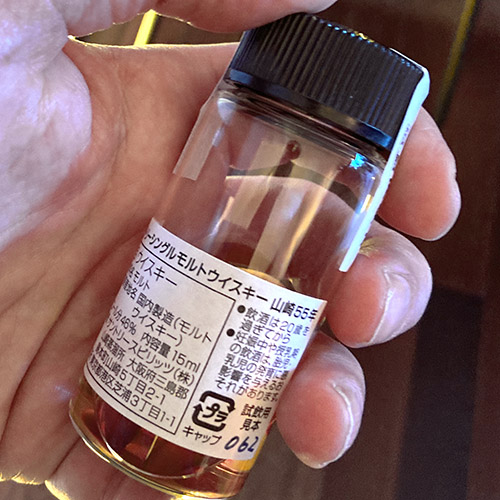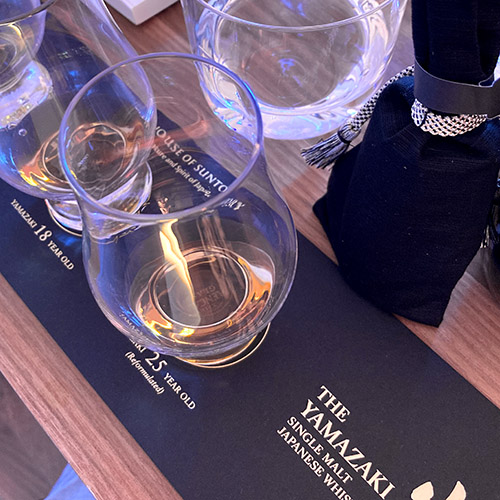A few days ago we were invited to a swanky event hosted by Japanese spirit aces the House of Suntory in a posh part of Highgate. After locating the iron (unused since lockdown began) in an attempt to look smart, I took the train to Waterloo before trekking across the capital on one of the hottest days September has ever known.
The event was a showcase of the Japanese Yamakazi Distillery’s range of single malt whiskies which culminated in the European launch of their 55 year old release. There was luxurious Japanese food on the menu, each course accompanied by cocktails featuring spirits from the wider Suntory range, but let’s not show off about that – it’s the whisky that is of most interest.
The Yamakazi Distillery
The Yamakzu Distillery began life in 1923, established by Suntory founder Shinjiro Torii, with the aim of producing whisky more suited to Japanese tastes than Scottish whisky, which was generally considered to have too many bold flavours. To create whisky of a more delicate nature, but without losing any of its complexity, the main focus in Japanese production is the whisky’s blending.
The Yamakazi Distillery produces a huge range of whiskies from numerous barleys, yeasts and casks before the distillery’s stars – their Master Blenders – set to work on their art. They carefully mix and marry various whiskies until their finely tuned taste buds detect whisky nirvana, and then they bottle them, without employing ‘finishing casks’ as is common in other parts of the world. Because all the whisky is produced from malted barley at the same distillery they are classified as Single Malts and, as is the case in Scotland, their age statement refers to the oldest whisky in each release.
Japanese Oak
Among the more distinctive whiskies that go into Yamakazi’s single malts blends are those that have been aged in mizunara (Japanese oak) casks. This less well known oak is apparently much harder to work with that European or American oaks. Besides having a higher moisture content than other oaks, and being tricky to turn into leak-proof casks, the tree doesn’t grow particularly straight (making it hard to find pieces suitable for staves) and you need permission from the Japanese government in order to cut one down.
One of the flavour characteristics commonly detected in whisky aged in mizunara oak is coconut. Taste buds and brain work differently every time we drink – context plays a huge part in how things taste, from what we ate before to what environment we’re drinking in, while even our mood can effect how we appreciate flavours.* When I’ve previously sipped Yamakazi whisky my brain has had to work hard to detect the coconut yet, for some reason, those flavours were prominent today – from desiccated coconut at the centre of sweet chocolates in some whiskies, to toasted, subtly bitter coconut in others.
Another common thread among the Yamakazi range (and the whiskies were generally very different tasting) was tropical fruit. Exactly what fruit was hard to pinpoint, but it was something akin to pineapple, which went from fresh and juicy in the younger expressions to dried and chewy in the older ones.
Yamakazi 55
The highlight of the evening was the unveiling of Yamakazi 55, the first tasting of the distillery’s oldest whisky to be held in Europe. With only 100 bottles available (the same quantity was released in Japan a year ago), each at a recommended retail price of $60,000**, we realise it’s a huge privilege to be able to taste such a spirit.
Aged for 55 years, it’s certainly the oldest whisky I’ve ever enjoyed. Previous ancient releases I’ve tried have been great experiences (there are always stories behind each launch that elevate the whisky, along with extravagant packing and media fanfares to heighten the excitement), and age does amazing things to the spirit, but I don’t believe they always improve on younger releases from the same distillery.
Yamakazi 55 is an exception in that it tastes like something entirely new. A whisky unlike anything I’ve tried before, and one that hasn’t been off-balanced by bucketloads of the leathery wood flavours I often encounter in aged whisky. The whisky tasted mature, but in the way a freshly picked fungus full of woodland flavours tastes simultaneously mature and new, and there was even a hint of tropical fruit freshness emerging through the darker notes: more mango than pineapple but most definitely there.
I’ll almost certainly never get to try this whisky again so I’ll cling on to the memory of a distinctive and distinguished whisky, mature but still very much alive and vibrant, and a unique expression of the Japanese Master Blender’s way of doing things.

The Yamakazi Whisky range
Below are the whiskies we tasted from the Yamakazi range, with tasting notes provided by the distillery.
Yamakazi Distiller’s Reserve, 43%
A good value introduction to Japanese Single Malt, and great in Japan’s favourite cocktail, the Highball. Around £70.
Nose: Strawberry, cherry, Mizunara (Japanese oak)
Palate: Raspberry, white peach, touch of coconut
Finish: Sweet vanilla, clear finish with, hint of cinnamon
Yamakazi 12 Year Old, 43%
More complex than most 12 year old whiskies, this is one to sip neat and savour. Around £135.
Nose: Peach, pineapple, grapefruit, clove, candied orange, vanilla, Mizunara (Japanese oak)
Palate: Coconut, cranberry, butter
Finish: Sweet ginger, cinnamon, long finish
Yamakazi 18 Year Old, 43%
We’re cranking up the price and quality with this one. An incredible whisky. Around £800.
Nose: Raisin, apricot, cafe au lait, Mizunara (Japanese oak)
Palate: Blackberry, strawberry jam, dark chocolate
Finish: Long, spicy, smooth
Yamakazi 25 Year Old, 43%
Hard to find, and even harder to afford. Lots of spicy orange and tasty oak in this one. £THOUSANDS.
Nose: Mizunara smoky notes of incense, followed by a complex bouquet of mature kaki persimmon and ume plum notes.
Palate: A smoky first sip of Mizunara sandalwood notes that open and deepen into complex layers of kaki persimmon subtle sweetness, tart ume plum notes and gentle shoga ginger spicy notes.
Finish: Profound long finish with Mizunara smokiness and lingering subtly sweet wood notes that remain.
Yamakazi 55 Year Old, 46%
A rare treasure. £HOW MUCH???
Nose: A robust aroma redolent of sandal wood. A sweet, mature bouquet like well-ripened fruit.
Palate: A soft, smooth first sip that blossoms in the mouth with flavor. A mixture of sweet and slightly bitter, followed by a woody note from the Mizunara cask.
Finish: Slightly bitter, a fragrance like scented wood and a hint of smokiness. A sweet, rich, lingering finish.

*As an example of how taste can change, I foolishly burnt my tongue earlier in the day on a hot cup of coffee. This meant that some of the hotter, spicier notes were accentuated when the whisky first hit the tip of my tongue.
**One of the Japanese bottles recently sold for $800,000.
Note: We’ve added affiliate links to some of these whiskies. Unfortunately we can’t find affiliate links to the more expensive bottles so our retirement plans are still on hold…








Great read! Will have to look into it